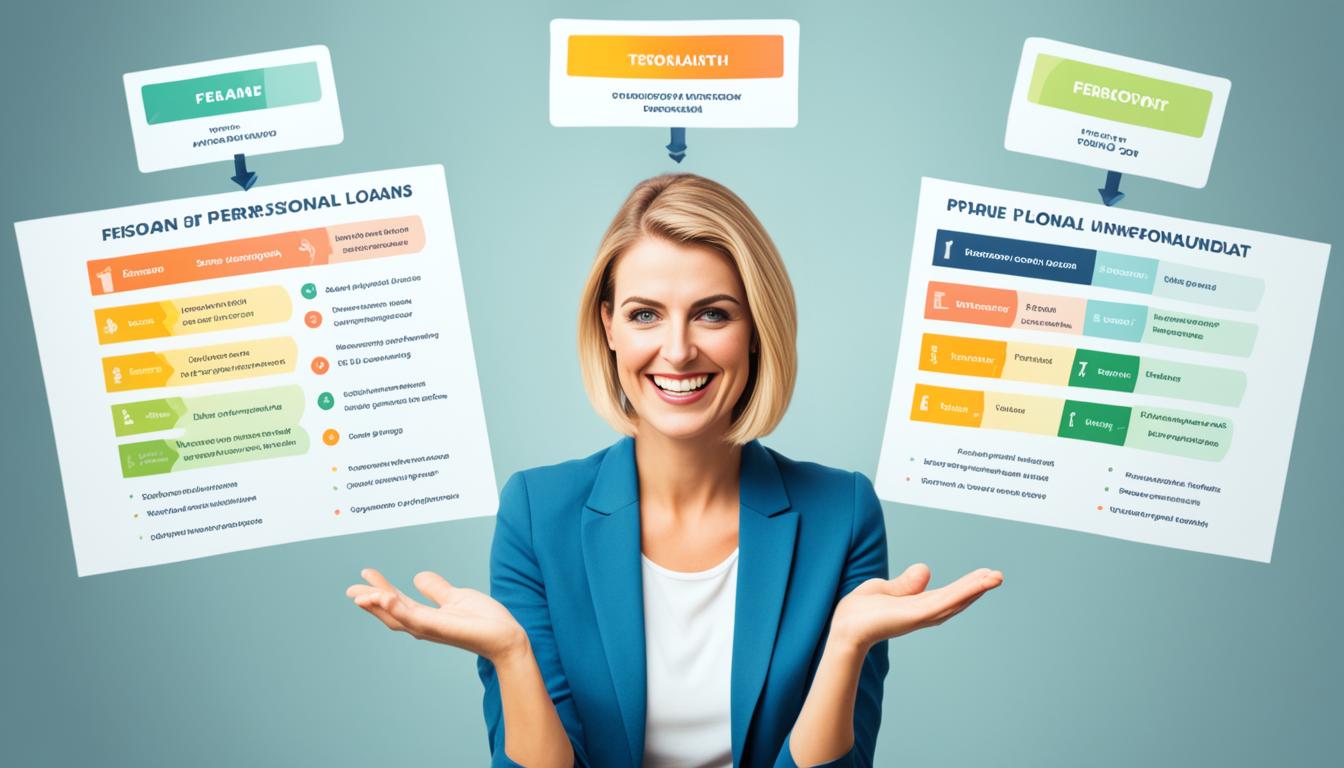Personal loans help people reach their goals and manage spending. They can be used to consolidate debt, buy big items, or handle sudden costs. These loans fit various needs.
Personal loans come in many forms, each with its own perks and uses. Here are the main types:
1. Secured Personal Loans: You need to offer something valuable, like a car or savings, with secured loans. This item is security for the lender. Lower interest rates are common with these loans. They suit people with assets who want better rates.
2. Unsecured Personal Loans: No collateral is needed for unsecured loans. Your credit history, income, and job stability matter more. Quick fund access and flexibility are the key benefits. This makes them a popular choice for many.
3. Debt Consolidation Loans: Combining high-interest debts into one, with lower interest, is what these loans do. They simplify your repayments and could save you money. Debt consolidation loans are about convenience and saving on interest.
4. Personal Line of Credit: Think of this like a flexible credit card. You have a fund you can draw from when needed. You only pay interest on what you use. It’s a way to have control over how and when you borrow.
This list covers just a few personal loan types. The key is to consider your needs and assess your financial status before choosing. Each option comes with its own set of advantages and things to think about.
Key Takeaways:
- Secured personal loans require collateral and offer lower interest rates.
- Unsecured personal loans do not require collateral and are based on credit history and income.
- Debt consolidation loans combine multiple debts into a single loan for easier repayment.
- Personal lines of credit provide flexibility and control over borrowing options.
- Consider your financial situation and goals when choosing a personal loan.
Unsecured Personal Loans
Unsecured personal loans don’t need collateral. This is good for people who can’t or don’t want to risk their assets like cars or homes.
Lenders look at your credit score, how much you make, and your job history. Having a good credit score and stable income helps you get better loan terms.
Not needing to put up collateral is a big plus. If you can’t pay back the loan, nothing you own gets taken away.
But skipping payments could hurt your credit score. The lender can take legal action to get their money back. So, it’s important to be careful and have a plan to pay it back.
Unsecured loans fit well for people with good credit and not a lot of debt. They’re used for many things, like combining debts, fixing up a home, or for medical costs.
Let’s see how a loan could help someone:
Jessica, a freelance graphic designer, has a lot of credit card debt with high interest. She has a great credit score and steady income. With an unsecured loan, Jessica might get a lower interest rate. This would make her payments simpler and help her pay off debt faster.
Benefits of Unsecured Personal Loans:
- No collateral required
- Based on creditworthiness and financial profile
- Funding available for various purposes
Even though these loans offer flexibility, it’s wise to think about the terms. Make sure to compare different loan options and think about how you’ll pay it back.
Remember, being smart about borrowing and managing debt is crucial. This keeps your finances in good shape.
Comparison of Unsecured Personal Loans vs. Secured Personal Loans
| Unsecured Personal Loans | Secured Personal Loans | |
|---|---|---|
| Collateral Requirement | No collateral required | Collateral, such as a vehicle or property, required |
| Interest Rates | Interest rates typically higher | Interest rates generally lower |
| Risk of Asset Loss | No risk of asset loss | Risk of losing collateral if loan defaults |
| Credit Requirements | Relies heavily on credit score and financial profile | Collateral acts as additional security for lenders |
| Loan Purposes | Flexible, can be used for various purposes | Usually limited to specific purposes |

As the table shows, unsecured loans avoid putting assets at risk. Yet, interest rates can be higher without collateral.
Before taking an unsecured loan, carefully check your finances and look at other options. Pick the loan that fits your needs and you can afford to repay.
Secured Personal Loans
Secured personal loans let people borrow money with lower interest rates. They need to give something valuable, like a savings account, as a promise to the lender.
Lenders see these loans as less risky because of the collateral. Thus, they offer better interest rates than unsecured loans.
If a borrower doesn’t pay back the loan, the lender can take the collateral. This is a big consequence of not repaying a secured personal loan.
These loans are good for those with not-so-great credit scores. By using collateral, it shows you’re serious about repaying. And that lowers the lender’s risk.
Before getting a loan, make sure you can pay it back. Understand your money situation. And make a plan to pay off the loan.
Debt Consolidation Loans
If you’re dealing with many high-interest debts, a debt consolidation loan could help. It lets you merge your debts into one. This gives you a chance for a lower interest rate.
By doing this, your monthly payments become simpler. No more tracking different due dates or amounts. Now, you just make one easy payment each month.
This type of loan can also cut down how much you spend on interest. High-interest debts are tough on your wallet, but a consolidation loan can lower these costs. This means you save money in the long run.
Debt consolidation is very useful if you have various high-interest debts. It works for credit cards, medical bills, and more. This loan can help you get a grip on your finances and step closer to being debt-free.
How Debt Consolidation Loans Work
When you want a debt consolidation loan, a lender checks your financial health. They look at your credit score, how much you earn, and your debts. The loan they offer is based on this info.
If you get the loan, the lender will pay off your debts directly. Then, you only have one monthly payment. This payment is usually smaller and easier to handle.
But remember, debt consolidation isn’t a quick fix. You need to manage your money well and avoid new debts. This will help you stay on the path to being debt-free.
The Benefits of Debt Consolidation Loans
Consolidation loans have various perks for anyone with lots of debts:
- Simplified Repayments: You only have to make one payment each month. This makes managing your debt much simpler.
- Lower Interest Rates: One loan can lower your interest rates. This saves you money in the long term.
- Reduced Stress: Having many debts is stressful. One loan is easier to deal with and can lower your stress.
Debt consolidation loans give you a way to improve your financial situation. But, it’s vital to pick a good lender. Look for one with good rates and terms.

Co-signed and Joint Loans
Obtaining a loan can be hard if you don’t meet all the requirements alone. This is where co-signed and joint loans come in. They increase the odds of getting a loan and let you benefit from better rates. Here’s how they work.
Co-signed Loans
In a co-signed loan, a creditworthy co-signer is added to the application. The co-signer guarantees they will pay if the borrower can’t. This makes it easier for the lender to approve the loan, trusting it will be paid back.
A creditworthy co-signer can often get you better rates and terms. Lenders look at the co-signer’s credit and income, not just the borrower’s. It’s great for those with not-so-great credit or a thin credit history.
But, if the borrower messes up, the co-signer’s credit takes a hit. It’s key for both to be on the same page about paying back the loan.
Joint Loans
Joint loans, however, are a bit different. They’re for two or more people applying for the loan together. In this setup, everyone involved is equally responsible for paying back the loan. The actions of one can affect the others’ credit.
These loans are common with couples or family members wanting to pool resources. They’re good for big buys like houses or cars. Here, the lender checks the credit and income of all applicants.
Understanding how to pay back the loan and having a plan is crucial for joint borrowers. Clear communication avoids potential problems later on.

Getting a creditworthy co-signer or opting for a joint loan can help when you can’t get a loan on your own. These choices increase your chances of approval and can get you better deals. Yet, be mindful of the risks and shared responsibilities.
Fixed-Rate Loans
Fixed-rate loans bring stability to borrowers. The interest rate stays the same throughout the loan. This makes it easier for borrowers to plan their finances well.
Borrowers pay a steady amount every month. This payment includes the loan amount and interest. Over time, the loan amount gets smaller.
Interest rates are set when you take the loan. They don’t change, no matter what happens in the market. This gives borrowers the peace of mind. They can budget without fearing their payments will go up suddenly.
These loans are great for those with good credit. They like to know exactly what they’ll pay each month. This way, they can budget better. Fixed-rate loans are good for mortgages, auto loans, or personal loans.

Fixed-rate loans have more good points:
- You could save on interest. Even if rates go up, your payment won’t.
- It’s easier to plan when you know how much the loan will cost over time.
So, if you like the idea of stable payments, fixed-rate loans are for you. Whether it’s a home, education, or debt, they offer peace of mind and financial stability.
Variable-Rate Loans
Variable-rate loans give you a chance to start with low interest rates. These rates can change over time, making it hard to budget for. Still, they can be good for those wanting a cheaper, short-term loan.
Understanding Interest Rates and APR
Interest rates and APR (Annual Percentage Rate) are vital in a variable-rate loan. The interest rate affects how much you pay to borrow money. Meanwhile, the APR shows the total cost, including extra fees.
This type of loan changes with the market, affecting your payments. Know how these changes could impact your budget and loan affordability.
Considerations for Choosing a Variable-Rate Loan
For a variable-rate loan, think about these factors:
- Check your financial health to handle rate increases. Think about if you can afford higher payments.
- Choosing a short loan term lowers the risk of big rate hikes. It also means less money paid in interest.
- Keep an eye on interest rate trends. This helps you pick the right time to apply for your loan.
Benefits and Drawbacks of Variable-Rate Loans
Here are the pros of variable-rate loans:
- They start with lower rates than fixed-rate loans. Your payments can be smaller at first.
- Lower rates in the future can mean paying less over time.
Yet, there are cons to think about:
- Not knowing your future payments can be hard to manage. As rates change, so will what you pay monthly.
- If rates go up by a lot, you might find it hard to keep up with payments.
A Visual Comparison
Let’s see how variable-rate loans and fixed-rate loans differ:
| Features | Variable-Rate Loans | Fixed-Rate Loans |
|---|---|---|
| Interest Rate | Can change over time | Stays the same |
| Monthly Payment | Changes with interest rates | Is steady |
| Payment Stability | Hard to predict | Easy to predict |
| Risk | May pay more if rates go up | No surprise payment increases |
It’s key to really think about variable-rate loans and see if they fit your financial needs. Always understand the loan’s terms before you agree. This way, you can make the best choice for you.
Personal Line of Credit
A personal line of credit lets you borrow as you need up to a fixed amount. It works like a credit card. You can take out money up to your limit and pay it back over time.
It comes with a great benefit. You pay interest only on what you borrow, not on the full limit. This means you control your interest costs. You save money by not borrowing more than you have to.
Need money from time to time or for various things? A personal line of credit might be your best bet. It’s there for you when life throws a curveball. It helps with short-term money gaps or keeps your projects going without a hitch.
Personal lines often have better interest rates than credit cards. This makes borrowing cheaper in the long run. You could save a lot on interest for big loans or if you need money for a while.
These lines can be secured or unsecured. Securing it means you back it up with something of value, like a savings account. Without that, it’s unsecured.
Before you pick a personal line of credit, look at all the details. Read about the rates, how you must pay back, and any fees. This way, you’ll choose the best one for your situation.
A personal line of credit is a handy tool. It gives you freedom to borrow when you need, at a good cost. You can pay back what you use over time, making things easier.
Key Features of a Personal Line of Credit:
- Access to a predetermined amount of funds
- Borrow funds as needed, up to the credit limit
- Interest charged only on the amount borrowed
- Flexible repayment options
- Can be secured or unsecured
- Lower interest rates compared to credit cards
Conclusion
Personal loans vary a lot, each one fitting a different financial situation. They help people, from those with great credit to those working on it. For people with high-interest debts, debt consolidation loans can be a real game-changer. These loans roll all debts into one, making it easier to manage.
Then, you have loans that need someone else to sign with you. These are co-signed and joint loans. They give you a better chance of getting approved if your credit’s not the best. For a steady interest rate, choose a fixed-rate loan. But, if you’re okay with rates changing, variable-rate loans might be the way to go. Personal lines of credit work like a flexible credit card, letting you borrow what you need when you need it.
Thinking carefully about borrowing is super important. Before getting a personal loan, know what you want to achieve. Pick the loan type that fits your goals and your financial situation. Also, check your credit score and think about how you’ll pay it back. Using a personal loan the right way can help you reach your financial dreams.
FAQ
What are the types of personal loans?
There are many personal loan types. You can get secured and unsecured loans. Also, there are debt consolidation loans, personal lines of credit, and more. Each type serves different needs.
What is an unsecured personal loan?
An unsecured loan doesn’t need collateral. Your credit score, income, and job history decide if you can get it. This loan type is good for those with high credit scores and little debt.
What is a secured personal loan?
A secured loan needs something valuable as security. This could be a savings account or CD. Compared to unsecured loans, they often have lower interest rates. But, if you don’t pay, you might lose what you used as security.
How does a debt consolidation loan work?
It’s a loan to combine high-interest debts into one. Usually, this lowers the interest rate. It makes paying off debts simpler and might save you money.
What are co-signed and joint loans?
Co-signed and joint loans are there to help you get better loan terms. They involve someone else who can help pay if you can’t. This sharing of loan responsibility can help get approved or get lower rates.
What are fixed-rate loans?
A fixed-rate loan keeps the same interest rate forever. Monthly payments stay steady, which is great for planning. It’s best for those who like predictability and have a steady income.
What are variable-rate loans?
With a variable-rate loan, the interest rate can change. At first, it might be lower than a fixed rate. But it could go up. This makes budgeting a challenge. It suits those who don’t plan on keeping the loan for long.
What is a personal line of credit?
It’s like a credit card but with better interest rates. You have a set amount you can borrow. You only pay interest on what you use. This is useful for when you need money but not all at once.
What should be considered when choosing a personal loan?
Think about your financial goals first. Your credit score, how much you make, and how you’ll repay the loan matter. It’s key to not over-borrow and pick the right loan for your needs.


















